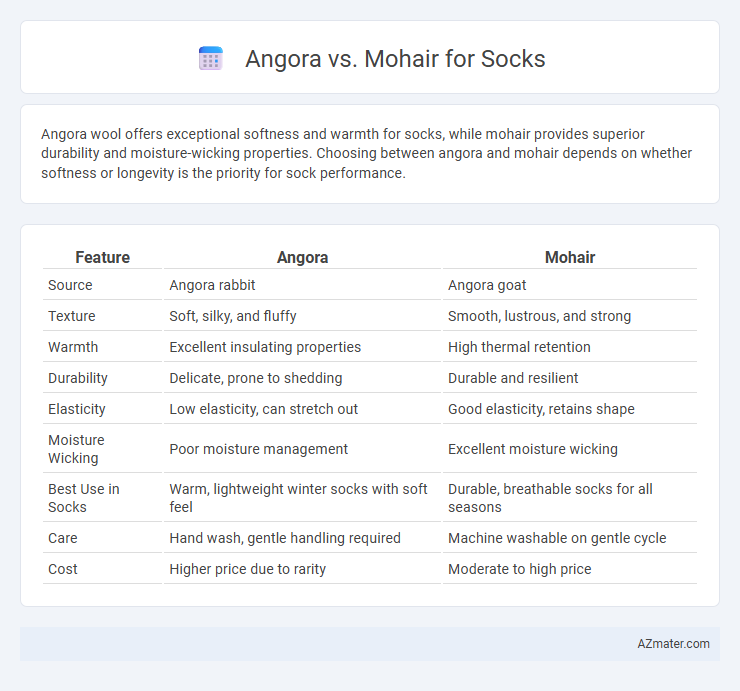Angora wool offers exceptional softness and warmth for socks, while mohair provides superior durability and moisture-wicking properties. Choosing between angora and mohair depends on whether softness or longevity is the priority for sock performance.
Table of Comparison
| Feature | Angora | Mohair |
|---|---|---|
| Source | Angora rabbit | Angora goat |
| Texture | Soft, silky, and fluffy | Smooth, lustrous, and strong |
| Warmth | Excellent insulating properties | High thermal retention |
| Durability | Delicate, prone to shedding | Durable and resilient |
| Elasticity | Low elasticity, can stretch out | Good elasticity, retains shape |
| Moisture Wicking | Poor moisture management | Excellent moisture wicking |
| Best Use in Socks | Warm, lightweight winter socks with soft feel | Durable, breathable socks for all seasons |
| Care | Hand wash, gentle handling required | Machine washable on gentle cycle |
| Cost | Higher price due to rarity | Moderate to high price |
Introduction to Angora and Mohair Fibers
Angora fibers come from the Angora rabbit and are renowned for their exceptional softness, warmth, and lightweight properties, making them ideal for luxurious sock construction. Mohair, derived from the Angora goat, exhibits high durability, elasticity, and a natural sheen, enhancing the longevity and aesthetic appeal of socks. Both fibers provide superior insulation and moisture-wicking capabilities, creating comfortable and breathable socks for various climates.
Origin and Source: Where Do Angora and Mohair Come From?
Angora fibers originate from the Angora rabbit, primarily bred in regions like China, France, and Hungary, renowned for its soft and silky texture ideal for luxury socks. Mohair comes from the Angora goat, mainly raised in South Africa, Turkey, and the United States, known for its strength, sheen, and durability in sock production. Both fibers offer unique benefits, with Angora providing exceptional warmth and Mohair contributing elasticity and resilience to high-quality socks.
Texture and Softness Comparison
Angora fibers, derived from the Angora rabbit, are renowned for their exceptional softness and silky texture, making them ideal for cozy, luxurious socks. Mohair, sourced from the Angora goat, features a smooth yet slightly coarser feel compared to Angora, offering durability with a soft sheen but less softness. When compared, Angora socks provide a more delicate, cloud-like softness, while Mohair socks balance softness with enhanced resilience and slight texture variation.
Warmth and Insulation Properties
Angora fibers offer exceptional warmth and superior insulation due to their hollow core structure that traps heat effectively, making them ideal for sock materials in cold climates. Mohair, derived from the Angora goat, provides durability and moisture-wicking properties but has slightly less insulating capability compared to Angora wool. Socks made with Angora blends excel in temperature regulation, ensuring warmth without overheating, while Mohair-enhanced socks balance thermal insulation with breathability for versatile wear.
Durability in Everyday Sock Wear
Mohair offers superior durability compared to Angora due to its firmer fiber structure, making it more resistant to abrasion and wear in everyday sock use. Angora, while exceptionally soft and warm, tends to be more fragile and prone to pilling, which reduces its longevity in high-friction areas like socks. For sock wear requiring long-lasting resilience, Mohair blends provide an optimal balance of comfort and durability.
Moisture Wicking and Breathability
Angora fibers in socks offer exceptional moisture-wicking properties due to their hollow core, which helps to pull sweat away from the skin while maintaining warmth. Mohair, derived from the Angora goat, provides superior breathability and durability, allowing air to circulate and keep feet dry during extended wear. Both fibers excel in moisture management, but Angora emphasizes insulation with moisture control, whereas Mohair balances breathability and resilience for socks designed for active use.
Allergen Considerations: Sensitivity and Comfort
Angora wool, derived from Angora rabbits, is known for its softness but may trigger allergic reactions due to lanolin content, affecting sensitive skin. Mohair, sourced from the Angora goat, tends to be less allergenic and more breathable, providing enhanced comfort for those prone to allergies. Both fibers offer moisture-wicking properties, but mohair's hypoallergenic qualities make it a preferable choice for allergen-sensitive sock wearers.
Care and Maintenance of Angora vs Mohair Socks
Angora socks require gentle hand washing with cool water and mild detergent to prevent fiber damage and maintain softness, while mohair socks are more durable and can often be machine washed on a gentle cycle. Both fibers benefit from air drying flat to retain shape and avoid shrinkage, but angora's delicate nature demands extra caution to avoid felting. Proper storage in a dry, cool place with cedar balls or lavender sachets helps protect both angora and mohair socks from moth damage and prolongs their lifespan.
Price and Availability Factors
Angora socks typically command higher prices due to the limited availability of Angora rabbit fur, which requires meticulous harvesting and processing. Mohair, sourced from the Angora goat, is more widely available and generally more affordable, making it a cost-effective option for durable, luxurious socks. Market trends show Mohair's consistent supply contributes to competitive pricing, while Angora remains a premium choice favored for its exceptional softness.
Choosing the Right Fiber for Your Perfect Socks
Angora fiber, renowned for its exceptional softness and warmth, offers luxurious comfort ideal for socks in cold climates, while mohair provides superior durability and elasticity, ensuring long-lasting wear and shape retention. Both fibers excel in moisture-wicking and breathability, making them excellent choices for maintaining foot health and preventing odor. Opt for angora if softness and insulation are your priorities, or mohair if you value strength and resilience in your perfect socks.

Infographic: Angora vs Mohair for Sock
 azmater.com
azmater.com